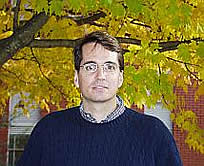 |
Prof. Francis RobicheauxI've been a
professor of physics at Purdue University since 2013 (previously at
Auburn University 1993-2013). My research area is Theoretical Atomic
Physics, focusing on coherence and decoherence in quantum
systems, many body processes when photons interact with many atoms,
highly
excited (Rydberg) atoms, strong fields, and
ultracold plasmas. My group typically consists of undergrads,
grad students, and postdocs. I'm a member of the ALPHA collaboration:
the first group to trap the antimatter version of the Hydrogen atom and
the only group to quantitatively measure its properties.
|
|
|
2 electron/3 electron continuumThe problem of two or more electrons in the continuum is both difficult and interesting. The difficulty arises because the the 2 or more electrons can interact over extremely large distances. This problem is interesting for the same reason because we would like to know how the electrons develop correlated motion in the continuum.The main tool we use to explore this problem is a direct, numerical solution of the time dependent Schrodinger equation (the last reference below is to a review article about this method). For electron impact ionization, we start the wave function with one electron in the ground state and the other in a continuum wave packet with momentum sending it to the atom/ion. Here is a movie of a model problem (tpa.avi) where all angular momenta are set to 0. The wave packet is such that electron 1 is the continuum electron localized at about 50 a.u. and electron 2 is in the ground state so is confined to small r. As time goes forward, the packet moves to small r1. At about 25 a.u. of time, electron 1 is at its smallest distance. At later times, the packet has three interesting pieces: (1) a part that goes back out with electron 1 going to large distance and electron 2 confined to small distances (this is elastic scattering and inelastic scattering to 2s, 3s states), (2) a part where electron 2 goes to large distances and electron 1 is confined to a small region (this is exchange scattering), and (3) a wide swath where both electrons 1 and 2 are going to large distances (this is ionization). To get accurate scattering probabilities, the wave function at late times is properly symmetrized and projected onto continuum final states. This basic numerical method has been applied to photo-double ionization of atoms/ions/molecules, electron impact ionization of atoms/ions/molecules, photo-triple ionization of atoms/ions, and electron impact double ionization of atoms/ions. Below is a brief description of results in two recent publications. X. Zhang, R.R. Jones, and F. Robicheaux, "Time-dependent electron interactions in double Rydberg wave packets," Phys. Rev. Lett. 110, 023002 (2013). PDF (539 kB) This paper presents experiments and calculations of the excitation and decay of double Rydberg wave packets. The Ba atoms were excited to a state where both valence electrons were in Rydberg wave packets. The time of excitation of the second packet was varied relative to the launch of the first packet to give a different phase of oscillation of the two electrons. F. Robicheaux, "Time propagation of extreme two-electron wavefunctions," J. Phys. B 45, 135007 (2012). PDF (397 kB) This paper presents a method for calculating the two electron wave function for atoms and ions when both electrons are in fairly extreme states. Calculations were performed for angular momentum up to 160 and for energies up to 1 keV. Five Recent Publications
Xiao Wang and F. Robicheaux, "Angular interferences of sequentially ionized double-continuum wave packets," Phys. Rev. A 98, 053407 (2018). PDF (1400 kB) Xiao Wang and F. Robicheaux, "Interference patterns from post-collision interaction in below-threshold photoexcitation Auger processes," Phys. Rev. A 98, 013421 (2018). PDF (1850 kB) M.S. Pindzola, J. Colgan, F. Robicheaux, T.G. Lee, M.F. Ciappina, M. Foster, J.A. Ludlow, and Sh.A. Abdel-Naby, "Time-dependent close-coupling calculations for ion-impact ionization of atoms and molecules," Adv. At. Mol. Opt. Phys. 65, 291 (2016). (email FR for pdf) Q. Wang, S. Sheinerman, and F. Robicheaux, "Comparison of different quantum mechanical methods for inner atomic shell photo-ionization followed by Auger decay," J. Phys. B 47, 215003 (2014). PDF (902 kB) M.S. Pindzola, T.G. Lee, Sh.A. Abdel-Naby, F. Robicheaux, J. Colgan, and M.F. Ciappina, "Neutron-impact ionization of He," J. Phys. B 47, 195202 (2014). PDF (275 kB) |
robichf[at]purdue.edu Links: |
